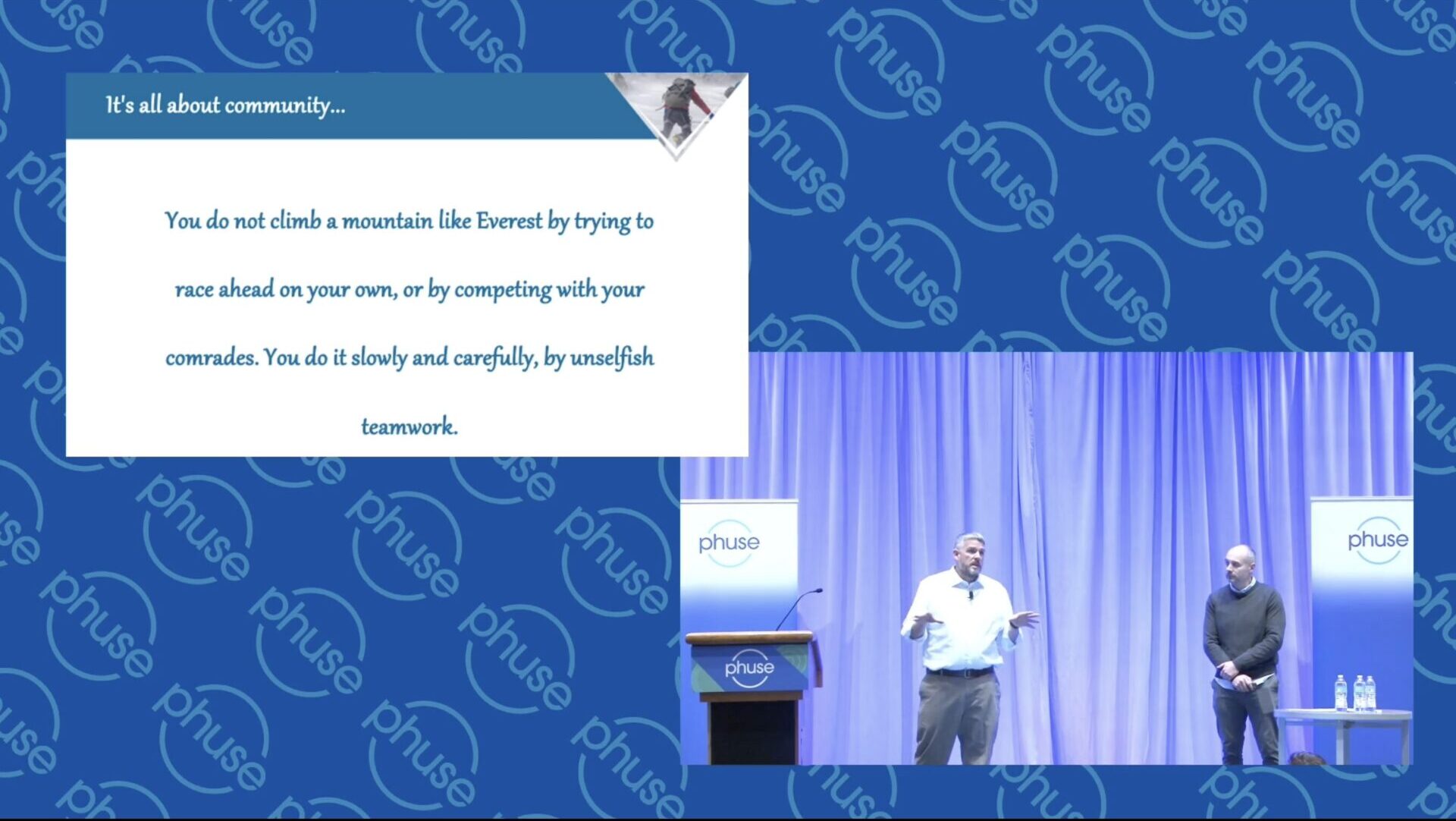Collaborating Across Pharma: Open Source Highlights from the PHUSE US Connect 2024 Keynote

The PHUSE US Connect 2024 keynote, delivered by Michael Rimler (GSK) and Ross Farrugia (Roche), served as an inspiring call to action for the pharmaceutical industry to embrace cross-organizational collaboration in developing open source solutions. The speakers emphasized how open source, when embraced through industry-wide cooperation, can drive transformative change by accelerating innovation, eliminating redundancy, and uniting organizations with a shared purpose: improving patient outcomes.
To illustrate this potential, the keynote featured insights from several industry leaders:
- Andrew York, Statistical Programming, Vice President, Novo Nordisk
- Alberto Montironi, Global Head, Statistical Programming, UCB Biosciences
- Li Zheng, Global Head, Analytical Data Science Enabling Platform, Roche/Genentech
- Mike Smith, Senior Director, Statistics, Lead R Centre of Excellence, Pfizer
- Samantha Warden, Global Head, Clinical Programming & Business Excellence, GSK
- Silke Hochstaedter, Head of Analytical Programming and Standard, Merck KGaA
While we cover just a few highlights from this presentation, you can watch the full keynote recording on the PHUSE website.
The open source advantage
Open source provides freely shared, licensed source code that allows for reuse, review, and modification. This drives robust and reliable software, offers flexibility in tool choices, and unlocks potential cost savings. However, its true power extends beyond these practical advantages. By its very nature, open source allows developers to adapt tools in ways not originally imagined. It offers a pathway to new solutions through collective problem-solving. This collaborative spirit is essential because, as the keynote speakers highlighted, many challenges faced in the pharma industry are common across organizations.
“Ask a question,” Michael encouraged, “and I’m confident that you’re gonna find out that…you’re not alone in having that question.” Engaging with open source from the start can resolve challenges that might otherwise be tackled in isolation.
While open source tools could be used in silos, Ross stressed that “the real strength of open source lies within industry collaboration.” It’s this collaborative spirit that unlocks the full potential of open source and allows it to truly accelerate drug development. By working together and adopting a “post-competitive” mindset, pharmaceutical organizations can accelerate innovation rather than slow progress by keeping tools and knowledge proprietary.
One compelling anecdote shared was the collaborative development of xportr, a package for creating .xpt (Standard Data Tabulation Model) files from R. When the Atorus team needed to add a feature, it required updates to two other open-source packages, one written in R and the other in C. Despite not being affiliated with pharma, the maintainers updated their libraries to support the feature. This exemplifies the spirit of open source: collective efforts driving solutions that extend far beyond their original intent.
Michael emphasized, “the biggest impact that any innovation can have in our industry, aside from actual new medicines and vaccines, of course, is getting those new medicines and vaccines to patients quickly and safely.” Open source enables this innovation, not just by making tools accessible, but by fostering a community-driven approach that turns individual contributions into transformative change.
To find out more about the importance of collaboration in open source, watch this clip:
The evolution of open source in pharma
The keynote speakers discussed the shift from initial skepticism about open source (“Can we trust it? How do we validate it?”) to its widespread adoption for “real clinical reporting work.” To highlight this evolution, they reviewed PHUSE papers from the past decade, finding that mentions of open source in conference papers rose from 9% in 2013 to 44% in 2023.
A recent Pharmaverse survey underscores the growing adoption of open source solutions. Of the 23 responding companies, 20 reported increasing their use of R, with only one anticipating a decrease. In the Shiny space, 21 companies reported using it for exploratory work, 8 for quality checks, and 5 for Good Practices (GxP) first-line programming. Michael and Ross also highlighted results from another survey of 18 pharmaceutical companies:
- Two-thirds have conducted some form of R-based submission.
- One-quarter plan to do full R-based submissions within three years.
- 90% plan to use SAS and R together in the foreseeable future.
Real-world applications and success stories
The industry has greatly benefited from the groundwork laid over the past years. Open source’s impact is evident in groundbreaking applications, as shared in this clip:
Open source is powering:
- End-to-end submissions: Roche has demonstrated the viability of open-source R code for regulatory submissions, including a pioneering end-to-end R submission for a new drug application to the FDA, EMA, and NMPA. Tools like OAK further accelerate this process, potentially making SDTM programming 3-5 times faster by reducing manual effort.
- Full R-based submissions: Novo Nordisk has completed a multi-study submission using R, as detailed in their joint webinar with Posit.
- Code parity: GSK aims to develop 50% of new code in open source languages by 2025 and has shared its strategy for enterprise adoption of open source.
- Reporting and visualizations: Open source tools like Quarto, Shiny, and teal allow investigators to gain deeper insights into clinical trial data. In a blog post, Eric Nantz from Eli Lilly shared some Shiny use cases within pharma, and Matthew Brierley and Joana Marques Barros from Idorsia Pharmaceuticals demonstrate Quarto use cases in pharma in their paper, In Theory to Practice: Harnessing R to Enhance Workflows.
Enabling open source success
To harness open source’s full potential and enable collaboration, companies must invest in training, infrastructure, and ongoing support for their teams. GSK, for example, discussed their upskilling programs in a recent webinar. Michael and Ross presented how other industry leaders support their teams:
These efforts do not have to be done individually. Ross noted that whenever there’s a roadblock, a group comes together to solve it collaboratively. Open source allows the community to leverage existing resources, tap into collective knowledge, and collaborate with others to overcome challenges. Numerous organizations and communities exist to support open-source collaboration in the pharmaceutical industry:
- The Pharmaverse is a community-driven initiative specifically focused on open source tools for clinical reporting and data analysis in the pharmaceutical industry.
- PHUSE offers a wealth of knowledge through its presentations, workshops, the PHUSE Education platform, and working groups, such as the Data Visualization and Open Source Technology Working Group.
- The R Consortium actively supports the R community and professional development.
- The R Submissions Working Group is actively collaborating with the FDA to test the feasibility of submitting artifacts built using R and Shiny through the regulatory submission portal.
- The free R/Pharma conference brings the community together to learn and collaborate, offering workshops and talks that teach individuals how to program in R.
- The R/Pharma Summit at posit::conf is an in-person event where leading pharmaceutical industry figures discuss the future of open source drug development. Join the next Summit on September 15 in Atlanta, GA.
- The R Validation Hub offers valuable guidance on validating R packages, addressing a common concern for those transitioning from proprietary software.
These initiatives reflect the growing communication and collaboration across the industry. “It’s amazing to be part of a collective that achieves so much more than you could as an individual on your own,” Ross reflected.
A collaborative future
As more organizations come together to address similar challenges, these collaborative efforts will accelerate innovation and drive even greater advancements in improving patient outcomes. This progress will only be amplified when the expectation and support for open sourcing tools and code become the norm. “Our hope,” stated Michael, “is that whenever somebody presents at a Connect on some sort of company-specific solution, that somebody in the audience is gonna raise their hand and say, ‘Well, wait a minute. When are you gonna open source your code?'”
To contribute further to collaborative efforts in pharma, join the R/Pharma Summit at posit::conf(2025), which will be held on September 15 in Atlanta, GA.
Resources and communities
- Posit Pharma Page
- Introducing CAMIS: A joint effort by PHUSE, PSI, and ASA to guide statistical implementations.
- PHUSE End-to-End Open-source Collaboration Guidance: A comprehensive resource developed by nine companies.
- PHUSE Open Source Technology in Clinical Data Analysis (OSTCDA): Addressing risks in open source adoption.
- PharmaDevOps: Automations for the Pharmaverse and related biostatistical packages.
- R-Ladies: Promoting gender diversity in the R community.
- ASA openstatsware: Developing statistical engineering packages.
- Bioconductor: Providing bioinformatics packages.
